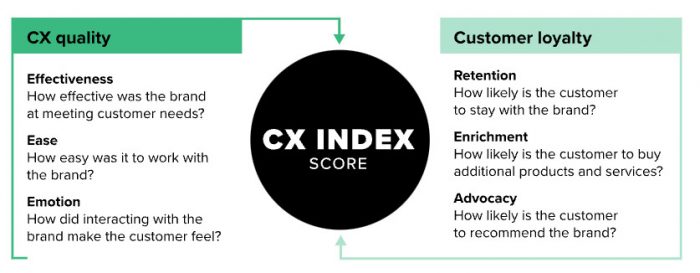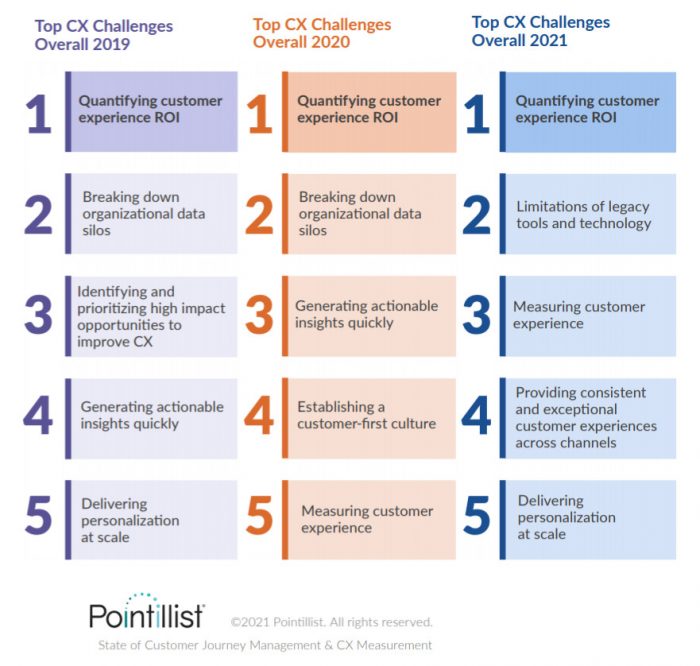Since yearly improvement is a sign of good health, what should you do when performance sags? If it’s your car or a student’s grades, or your health or your revenue, you would explore what’s broken or outdated. Accordingly, sagging performance in the Forrester 2022 CX Index is a wake-up call to explore what’s broken or outdated in your customer experience (CX) strategy.
State of CX
The 2022 CX Index reports a return to early 2020 CX quality levels, reversing 2021 gains. In fact, 20% of brands have lower CX quality now than a year ago. Furthermore, only 3% of companies are customer-obsessed, reduced from 10% in 2021. (96,000+ US consumers rated 221 brands in 13 industries.)1
As you can see in the 2020 graphic below, no industry has ever performed in the Good or Excellent levels.2 “Between 2021 and 2022, the average score dipped from 72.0 to 71.3.”3 This is like a “C-minus” grade on a school report card.

Success Factors
The index’s 6 quality/loyalty factors can be applied universally to employee experience and partner experience (EX and PX), in addition to customer experience, across all organization sizes and sectors.

Forrester points to emotion as the stand-out success factor among top performers. “The top 5% of brands in the entire CX index had a 15-point advantage over others in providing emotionally positive experiences for customers. . . . 59% of customers trust the brands they interact with, 2 percentage points higher than 2020.”1
Broken or Outdated CX Strategies
Be careful, however, in mistaking interactions as the key to customer experience success. For instance, consider your purchases in the past month where your interaction with the seller was minimal, and your interaction with the maker was non-existent. Are you likely to recommend or rebuy those brands? Would this likelihood possibly decrease if you discovered a need to interact further with the seller or manufacturer?
- Lesson: interaction is over-emphasized in popular CX strategies. While interaction quality is important, there is much more to customer experience excellence than interactions.
Success factors for ease of working with a brand extend far beyond interactions. Ease of business is dictated to a great degree by policies, processes, handoffs, and attitudes among the seller’s or maker’s headquarters groups.
Thinking of frustrations you’ve faced with various brands, you’re likely to acknowledge that effectiveness in meeting your needs hinges on all departments’ mindfulness of your preferences in all aspects of running their business. Indeed, costs, convenience, responsiveness, legal policies, and proactiveness are shaped by a brand’s organization-wide customer-centricity.
- Lesson: touch-points are over-emphasized in popular CX strategies. Extensive value is created or jeopardized “behind the scenes” in organizations. Likewise, large portions of the customer journey occurs outside of a brand’s touch-points.
Likely to recommend, likely to buy more, and likely to stay with the brand revolve around the 3 CX quality factors. When a brand is hard to work with, weak at meeting customer needs, or poor in generating positive interactions, it’s unnatural to expect opposite performance in the 3 customer loyalty factors.
In fact, if you are seeing higher performance in the customer loyalty factors compared to the CX quality factors, then it’s likely that your loyalty spending is extremely high. You may be able to entice loyalty factors for a while, but those gains are unsustainable without commensurate strengths in each of the quality factors.
As a case in point, how is it that quantifying CX ROI is consistently the number one challenge in Pointillist’s study4 for the past 3 years?

This is an alarmingly persistent challenge, considering that NPS® has been touted as the darling of CX metrics since the 2009 global economic downturn.
If strong performance in likely to recommend was as powerful as people believed in the 2010s, then quantifying CX ROI should NOT be the top challenge today, especially after a dozen years of heavy investment in asking the likely to recommend question.
In fact, major brands have occasionally disbanded their entire CX team (except for Service), only to start again later on.5
- Lesson: likely to recommend is a goal, not a means. The means toward recommendations is CX quality excellence before something goes wrong.
- Lesson: quantifying CX ROI hinges on excelling in challenges 2 through 5 in the Pointillist list. ROI occurs when something changes.
For example, to perform better on exams or to lose weight, a person must change their habits.
Similarly, CX ROI and sustained gains in recommend, buy more, and stay with the brand are earned by smoothing silos, identifying high impact CX improvement areas, generating actionable insights quickly, and establishing a customer-first culture. To achieve the goal, focus on its prerequisites.
Necessary, Yet Insufficient
“Return to normal” CX strategies are business performance quicksand. So much has changed in success criteria for employees and customers!
Practices deemed sufficient before the global pandemic are now insufficient. For today’s circumstances, popular CX strategies of yesteryear are broken or outdated.
In the 2010s, CX strategies were shaped by the global economic downturn of 2009: convert customers to brand allies and convert Service from a cost-center a profit-center. These CX strategies are an extension of the Marketing and Sales departments: generate brand references and positive word-of-mouth for new customer acquisition, and offset cost to serve with up-selling, cross-selling, fees, and penalties.
- Lesson: over-emphasis on emotion, enrichment, and advocacy are damaging trust and relationship strength. Evidence of this can be seen in the employee experience fiasco of the Great Reshuffle.
It’s called out in many places like the Edelman Trust Barometer, the Adecco Resetting Normal study, and the media’s declaration of skimpflation. CX excellence is not an extension of Marketing or Sales or Service.
Expansions in Customer Success, Customer Service, CRM, and Loyalty investments generally signal sloppiness among non-customer-facing groups. Consider this: if efforts company-wide are truly in-tune with your core-growth customers’ expectations, then they will prevent issues and generate natural retention, trust, and relationship strength.
- Lesson: expansion of touch-point investments may give the appearance of senior leadership commitment to CX excellence. But this may be a mirage, making up for corners cut in doing the right things right consistently.
To-date, CX strategies have emphasized personalization, data and privacy management, digitalizing service, reducing service effort, content marketing and customer references, designing journeys, listening more in real-time, increasing real-time closed loop communication, and/or migrating detractors and passives to promoters. With these tremendous investments, it’s incredible that no industry has pierced the glass ceiling of Good or Excellent in the CX Index.
- Lesson: customer experience is affected by much more than popular CX focus areas. To test this, consider your own experience as an employee.
Will EX excellence be guaranteed via employee personalization, data and privacy management, digitalizing employee services, and internal messaging and employee references?
Would the Great Reshuffle have been avoided by designing employee journeys, listening more to employees in real-time, increasing real-time closed loop communication to employees, and migrating employee detractors to employee promoters?
That’s all good, but what about the end-to-end employee experience, employees’ intended outcomes, balance, sense of appreciation, and so forth?
At the heart of the EX dilemma is mis-aligned motivations, lack of mutual respect for interdependencies, and weak follow-through on commitments. At the heart of both the EX and CX solutions is deeper understanding of intended outcomes, prevention of negatives, and ongoing focus on relationship strength.
CX Strategy for 2020s
In the 2020s, CX, EX, and PX practices must shift to higher standards of balance in how we listen, how we monitor performance, how we acquire and retain, how we act on what we learned, and preventing negatives as the foundation for sustained value creation.
- Balance your CX listening between Expectations VoC and Realities VoC.
- Ask for Realities VoC as often as you make changes to the realities that customers experience.
- Ask for Expectations VoC as often as conditions change for customers.
- Make it possible for customers to give you feedback anytime, anywhere, any way.
- For the CX Index, this is your foundation to stellar performance in effectiveness and enrichment.
- Balance performance standards of all groups with emphasis from Expectations VoC.
- Every group has people standards and budget standards, yet people and budget are made possible through customers funding them.
- Any group can mess up CX, so ensure a strong 3-legged stool for everyone with people, financial, and CX performance.
- Do not fall into the trap of using survey scores for CX as performance targets, PLEASE! Instead, identify behaviors/deliverables that are prerequisites to great CX, internally and externally, and monitor these.
- For the CX Index, this is your key to effectiveness stellar performance.
- Balance acquisition and retention: emphasize relationship strength and lifetime value.
- By focusing Sales on your ideal customer profile, you’ll minimize cost to serve, employee burnout, and churn of all types.
- For the CX Index, this is your key to retention excellence.
- Balance listening and acting.
- Use text/voice/video mining to maximize value of almost-free VoC and ask more interesting questions in surveys, building from almost-free insights.
- Conduct a read-out for every group across your company, accompanied by an actioning workshop. We did this with 50+ groups globally in our firm, creating 100+ action reports addressing root causes of customer loyalty issues. All 100+ action plans were monitored quarterly by our senior leadership team.
- This type of CX improvement is the heart of CX ROI!
- For the CX index, this is your key to ease, emotion, and advocacy stellar performance.
- Balance Ease of Work and Ease of Business.
- This is the foundation for your success in all of the above.
- “Ease” doesn’t mean easy. It means preventing negatives.
- Ease of Work and Business means aligning all you do to run your business toward strengthening relationships with employees, customers, and partners.
- It means company-wide alignment to expectations of these 3 stakeholders as “the hand that feeds you.”
- Ease of Work is the equivalent of Employee Experience Excellence.
Organizational success research conducted by ClearAction Continuum shows the root of EX angst are 3 success factors:- Getting everyone on the same page through aligned motivations.
- Creativity within boundaries by respecting inter-dependencies.
- Driving commitment through consistency to intentions.
- Ease of Business is the equivalent of Experience Excellence for customers, partners, and employees.
Ease of Work is its prerequisite. Additionally, Ease of Business has 3 success factors:- Getting and keeping customers through lifetime value mindset (and partners and employees).
- Data and metrics that inspire customer-centered action (and partner-centered and employee-centered action).
- Growth and innovation through enterprise use of CX insights (and PX and EX insights).
- Ease of Work is the equivalent of Employee Experience Excellence.
Shift gears right away to the new normal: agility to meet the 2020’s dynamic environment through company-wide alignment to your core-growth customers’ intended outcomes.
Unlearn what’s broken and outdated. Re-learn trust-building and relationship strengthening. This happens only when it’s combined at all levels: personal, peer interaction, company-employee, and externally.
Will your company be the first to achieve Excellent performance in the CX Index?
1Forrester’s US 2022 Customer Experience Index: Nearly 20% of Brands See Drop in Customer Experience Quality.
2Forrester’s 2020 CX Index Report: Scores Rise Even During Covid.
3US Customer Experience Index, 2022, Shows That Brands Struggled During the Past Year.
42021 Study of Customer Journey Management & CX Measurement.
5Cisco Axes Hundreds of Jobs Note: similar cuts were made during hard times in the 2010s at Adobe, HP, Intuit, Symantec, and others.



